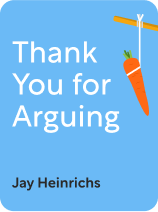

This article is an excerpt from the Shortform book guide to "Thank You for Arguing" by Jay Heinrichs. Shortform has the world's best summaries and analyses of books you should be reading.
Like this article? Sign up for a free trial here .
What is logos in the context of persuasion? How can you use logos to evaluate an argument?
Logos is used in persuasive arguments to convey logic and reason. Alternatively, you can use logos to evaluate an argument. There are three aspects of a rhetorical fallacy that you should keep an eye out for: weak proof, a bad conclusion, or a proof-conclusion disconnect.
Here’s how to evaluate an argument and identify faulty logic using logos.
Use Logos to Judge Others’ Arguments
In his book Thank You for Arguing, Jay Heinrichs explains how to evaluate an argument by spotting faulty logic and identifying rhetorical fallacies. Rhetorical fallacies typically fall into three categories—weak proof, wrong number of choices, and a proof-conclusion disconnect.
Fallacy Type #1: Weak Proof
Heinrichs says that weak proof fallacies often initially seem convincing. However, if you inspect the argument more closely, you’ll find that the proof doesn’t support the conclusion. Examples include:
False analogy: Your persuader argues that because she’s successful in one way, she’ll be successful in an unrelated way. You’ll see this frequently in politics. Many candidates discuss their life experiences—as a mother or a soldier or a businessperson—as “proof” of their ability. However, these experiences are unrelated to political experience and doing well in public office.
(Shortform note: Persuaders often use this tactic in a more subtle way than claiming that their experiences directly translate into ability. Instead, they use their experiences to convince you that they understand you in a way other people can’t, compelling you to trust them. For example, Alexandria Ocasio-Cortez ran much of her campaign for Congress on her background as a bartender in New York City. She pushed the idea that, with her background, she’s equipped to understand other “regular people” in a way most politicians can’t.)
Fallacy of power: Your persuader tries to convince you that because someone in a position of power made the same choice she’s advocating to you, it must be right. However, a powerful person won’t always make the best choices, and their choice may not be best for you. For example, if a colleague wants to convince you to start work at 6 a.m., he might say, “The CEO is always in his office by 6. If he does it, it must be a good idea.”
(Shortform note: This fallacy is often effective because it taps into a particular “heuristic,” or automatic shortcut your brain creates to quickly analyze situations and make decisions. Throughout your life, you were likely trained to obey and trust authority figures—this formed a heuristic: When an authority figure says something is the right thing to do, your brain automatically accepts it.)
Fallacy Type #2: Bad Conclusion
Heinrichs warns you to keep an eye on how many choices your persuader is giving you in their argument. Bad conclusion fallacies often give you only one or two choices, instead of the true range of available choices. The most common version is the false dilemma fallacy:
False dilemma: This fallacy frames your choice as “either, or” when there are actually many choices available. For example, if your CEO is looking for ways to save money, he might say, “We can cut either overtime pay or Christmas bonuses.” There are many ways for an organization to save money, but the false dilemma restricts the choices to two types of pay cuts.
(Shortform note: In The Art of Thinking Clearly, Rolf Dobelli says that by artificially constricting your options, this fallacy can easily manipulate you into choosing the “better” of the two given options (though often, neither is particularly good). He suggests taking a step back to consider a wider pool of alternatives that your opponent may be keeping from you.)
Fallacy Type #3: Proof-Conclusion Disconnect
Heinrichs explains that proof-conclusion disconnect fallacies either deliver a conclusion that’s irrelevant to the argument, or they create a false link between proof and conclusion.
The straw man fallacy: Your opponent focuses on one part of your argument and distorts it, misinterprets it, or oversimplifies it so that it becomes an easy-to-attack “straw man.” For example, “You’re against abstinence-only sex education? You’re basically encouraging teenagers to have sex and end up pregnant.” The argument shifts from the complex issue of sex education toward the simple, easy-to-attack issue of whether to encourage teen pregnancy.
(Shortform note: It can be frustrating to have your opponent distort your argument in this way, but be careful not to engage with their distortion. This is what they want—for you to adopt, in any way, the easy-to-attack position they’ve assigned you. Instead, stay calm and continually redirect the conversation back to the original argument: “I think you’ve gotten off track here. What we’re discussing is what type of sex education to provide in our school.”)
The Chanticleer fallacy: This fallacy assumes that when one incident follows another, the first must have caused the second (named for the fabled rooster Chanticleer, who thought that his crowing caused the sun to rise). In other words, there’s a mix-up between causation and correlation. For example: “Women who own horses have a longer average lifespan than those who don’t. Having a horse therefore contributes to longevity.” This argument assumes that horse ownership causes longevity, but the two are only correlated. It’s more likely that the type of women who can afford horses can also afford top-notch health care.
(Shortform note: If your opponent uses this fallacy to convince you of causation where you feel there may only be correlation, try deliberately slowing down your thinking. Look for more obvious causes by repeatedly asking yourself, “Why?” (for example, “Why would the type of women who own horses live longer?”) and considering the situation’s nuances.)

———End of Preview———
Like what you just read? Read the rest of the world's best book summary and analysis of Jay Heinrichs's "Thank You for Arguing" at Shortform .
Here's what you'll find in our full Thank You for Arguing summary :
- Smarter ways to argue and evaluate others’ arguments
- How to persuade people to do what you want
- How you can get a bully to talk himself down






